The Rheology of Graphene Oxide Dispersions in Highly Viscous Epoxy Resin: The Anomalies in Properties as Advantages for Developing Film Binders
Abstract
1. Introduction
2. Materials and Methods
2.1. Materials
2.2. Synthesis of GO
2.3. Preparation of GO/DEN-438 Formulations Using Homogeneous Liquid Phase Transfer Method
2.4. Characterization of GO–Epoxy Dispersions
2.4.1. Rheological Measurements
Steady Test
Dynamic Test
2.4.2. DSC Experiments
2.4.3. Optical Microscopy
3. Results and Discussion
3.1. Glass Transition Properties and Optical Microscopy
3.2. Rheological Properties
3.2.1. Oscillatory Shear Sweeps
- Temperature factor
- Angular frequency dependencies
3.2.2. Steady Shear Sweeps
4. Conclusions
Supplementary Materials
Author Contributions
Funding
Data Availability Statement
Conflicts of Interest
Abbreviations
| GO | graphene oxide |
| DEN-438 | brand of epoxy novolac resin |
| NPEL-128 | brand of epoxy dianic resin |
| RFI | Resin Film Infusion process |
| RTM | Resin Transfer Molding process |
| DSC | differential scanning calorimetry |
| IPA | i-propyl alcohol |
| Tg | glass transition temperature |
| σ | shear stress |
| η | viscosity |
| γ | shear rate |
| G′ | storage shear modulus |
| G″ | loss shear modulus |
| Tan(delta) | mechanical loss tangent |
| |η*| | complex shear viscosity |
| ω | frequency range |
| T20 | temperature at which a viscosity of 20 Pa·s is achieved |
References
- Hao, S.; Hou, S.; Liu, Y.; Nan, D.; Xu, D.; Shen, W.; Kang, F.; Huang, Z.-H. Enhanced anticorrosion of waterborne epoxy coatings by electrochemical exfoliated graphene oxide. Prog. Org. Coat. 2025, 202, 109147. [Google Scholar] [CrossRef]
- Li, P.; Liu, H.; Lin, B.; Zhu, Y.; Liang, C. Graphene oxide loaded dopamine modified zirconium dioxide nanocomposites to enhance the corrosion resistance of epoxy resin coatings. J. Mater. Res. Technol. 2025, 35, 5717–5729. [Google Scholar] [CrossRef]
- Wan, H.; Min, W.; Geng, L.; Li, Y.; Song, D.; Chen, C. Design a new type of composite coating of functionalized graphene oxide-composite pyrrhotite/waterborne epoxy resin with excellent hydrogen barrier performance. Corros. Sci. 2025, 256, 113261. [Google Scholar] [CrossRef]
- Chen, L.; Liu, J.; Liu, H.; Liu, Z.; Song, Q. Synergistic effect of graphene oxide and glass fiber on mechanical and thermal properties of composites: Experimental and simulation investigations. React. Funct. Polym. 2025, 210, 106201. [Google Scholar] [CrossRef]
- Li, N.; Zhang, Y.; Xu, Y.; Li, J. Graphene/epoxy coating with radiation heat dissipation properties for spacecraft thermal management. Chem. Eng. J. 2025, 519, 165105. [Google Scholar] [CrossRef]
- Ping, T.; Pan, X.; Tang, E.; Yuan, M.; Xing, X.; Chu, X.; Liu, S.; Li, H.; Cui, J. Enhancing antistatic property of epoxy resin coatings via formation of conductive networks with fibrous polyaniline/reduced graphene oxide. Constr. Build. Mater. 2025, 478, 141191. [Google Scholar] [CrossRef]
- Dreyer, D.R.; Park, S.; Bielawski, C.W.; Ruoff, R.S. The chemistry of graphene oxide. Chem. Soc. Rev. 2010, 39, 228–240. [Google Scholar] [CrossRef] [PubMed]
- Li, J.J.; Zhu, W.J.; Zhang, S.F.; Gao, Q.; Li, J.Z.; Zhang, W. Amine-terminated hyperbranched polyamide covalent functionalized graphene oxide-reinforced epoxy nanocomposites with enhanced toughness and mechanical properties. Polym. Test. 2019, 76, 232–244. [Google Scholar] [CrossRef]
- Gonçalves, M.G.; Costa, V.O.; Martinez, A.H.G.; Régnier, B.M.; Gomes, G.C.B.; Zarbin, A.J.G.; Orth, E.S. Functionalization of graphene oxide via epoxide groups: A comprehensive review of synthetic routes and challenges. Front. Carbon 2024, 3, 1393077. [Google Scholar] [CrossRef]
- Shi, G.; Song, J.; Tian, X.; Liu, T.; Wu, Z. High-performance epoxy nanocomposites via constructing a rigid-flexible interface with graphene oxide functionalized by polyetheramine and f-SiO2. Carbon 2024, 216, e118591. [Google Scholar] [CrossRef]
- Shim, Y.H.; Lee, K.E.; Shin, T.J.; Kim, S.O.; Kim, S.Y. Wide concentration liquid crystallinity of graphene oxide aqueous suspensions with interacting polymers. Mater. Horiz. 2017, 4, 1157–1164. [Google Scholar] [CrossRef]
- Ramos-Fernandez, G.; Muñoz, M.; García-Quesada, J.C.; Rodriguez-Pastor, I.; Martin-Gullon, I. Role of graphene oxide surface chemistry on the improvement of the interlaminar mechanical properties of resin infusion processed epoxy-carbon fiber composites. Polym. Compos. 2018, 39, E2116–E2124. [Google Scholar] [CrossRef]
- Vallés, C.; Beckert, F.; Burk, L.; Mülhaupt, R.; Young, R.J.; Kinloch, I.A. Effect of the C/O ratio in graphene oxide materials on the reinforcement of epoxy-based nanocomposites. J. Polym. Sci. Part B Polym. Phys. 2016, 54, 281–291. [Google Scholar] [CrossRef]
- Bortz, D.R.; Heras, E.G.; Martin-Gullon, I. Impressive Fatigue Life and Fracture Toughness Improvements in Graphene Oxide/Epoxy Composites. Macromolecules 2012, 45, 238–245. [Google Scholar] [CrossRef]
- Rafiee, M.; Nitzsche, F.; Laliberte, J.; Hind, S.; Robitaille, F.; Labrosse, M. Thermal properties of doubly reinforced fiberglass/epoxy composites with graphene nanoplatelets, graphene oxide and reduced-graphene oxide. Compos. Part B Eng. 2019, 164, 1–9. [Google Scholar] [CrossRef]
- Pathak, A.K.; Borah, M.; Gupta, A.; Yokozeki, T.; Dhakate, S.R. Improved mechanical properties of carbon fiber/graphene oxide-epoxy hybrid composites. Compos. Sci. Technol. 2016, 135, 28–38. [Google Scholar] [CrossRef]
- Watson, G.; Starost, K.; Bari, P.; Faisal, N.; Mishra, S.; Njuguna, J. Tensile and flexural properties of hybrid graphene oxide/epoxy carbon fibre reinforced composites. IOP Conf. Ser. Mater. Sci. Eng. 2017, 195, 012009. [Google Scholar] [CrossRef]
- Keyte, J.; Pancholi, K.; Njuguna, J. Recent Developments in Graphene Oxide/Epoxy Carbon Fiber-Reinforced Composites. Front. Mater. 2019, 6, 224–254. [Google Scholar] [CrossRef]
- Pathak, A.K.; Garg, H.; Singh, M.; Yokozeki, T.; Dhakate, S.R. Enhanced interfacial properties of graphene oxide incorporated carbon fiber reinforced epoxy nanocomposite: A systematic thermal properties investigation. J. Polym. Res. 2019, 26, 23–36. [Google Scholar] [CrossRef]
- Vryonis, O.; Virtanen, S.T.H.; Andritsch, T.; Vaughan, A.S.; Lewin, P.L. Understanding the cross-linking reactions in highly oxidized graphene/epoxy nanocomposite systems. J. Mater. Sci. 2019, 54, 3035–3051. [Google Scholar] [CrossRef]
- Amirova, L.; Surnova, A.; Balkaev, D.; Musin, D.; Amirov, R.; Dimiev, A.M. Homogeneous liquid phase transfer of graphene oxide into epoxy resins. ACS Appl. Mater. Interfaces 2017, 9, 11909–11917. [Google Scholar] [CrossRef]
- Surnova, A.; Balkaev, D.; Musin, D.; Amirov, R.; Dimiev, A.M. Fully exfoliated graphene oxide accelerates epoxy resin curing, and results in dramatic improvement of the polymer mechanical properties. Compos. Part B 2019, 162, 685–691. [Google Scholar] [CrossRef]
- Dimiev, A.M.; Surnova, A.; Lounev, I.; Khannanov, A. Intrinsic Insertion Limits of Graphene Oxide into Epoxy Resin and the Dielectric Behavior of Composites Comprising Truly 2D Structures. J. Phys. Chem. C 2019, 123, 3461–3468. [Google Scholar] [CrossRef]
- Dimiev, A.M.; Lounev, I.; Khamidullin, T.; Surnova, A.; Valimukhametova, A.; Khannanov, A. Polymer Composites Comprising Single-Atomic-Layer Graphenic Conductive Inclusions and Their Unusual Dielectric Properties. J. Phys. Chem. C 2020, 124, 13715–13725. [Google Scholar] [CrossRef]
- Del Giudice, F.; Cunning, B.V.; Ruoff, R.S.; Shen, A.Q. Filling the gap between transient and steady shear rheology of aqueous graphene oxide dispersions. Rheol. Acta 2018, 57, 293–306. [Google Scholar] [CrossRef]
- Kalghatgi, S.R.; Kumar, S.K.; Mani, E. Molecular Dynamics Study of the Role of Nanoparticle Assemblies on Polymer Nanocomposite Rheology. Macromolecules 2024, 57, 9555–9564. [Google Scholar] [CrossRef]
- Lin, F.; Tong, X.; Wang, Y.; Bao, J.; Wang, Z.M. Graphene oxide liquid crystals—Synthesis, phase transition, rheological property, and applications in optoelectronics and display. Nanoscale Res. Lett. 2015, 10, 435–451. [Google Scholar] [CrossRef]
- Vallés, C.; Young, R.J.; Lomax, D.J.; Kinloch, I.A. The rheological behaviour of concentrated dispersions of graphene oxide. J. Mater. Sci. 2014, 49, 6311–6320. [Google Scholar] [CrossRef]
- Corker, A.; Ng, H.C.H.; Poole, R.J.; Garcia-Tunon, E. 3D printing with 2D colloids: Designing rheology protocols to predict “printability” of soft-materials. Soft Matter 2019, 15, 1444–1456. [Google Scholar] [CrossRef]
- Sasikala, S.P.; Lim, J.; Kim, I.H.; Jung, H.J.; Yun, T.; Han, T.H.; Kim, S.O. Graphene oxide liquid crystals: A frontier 2D soft material for graphene-based functional materials. Chem. Soc. Rev. 2018, 47, 6013–6045. [Google Scholar] [CrossRef]
- Tesfai, W.; Singh, P.; Shatilla, Y.; Iqbal, M.Z.; Abdala, A.A. Rheology and microstructure of dilute graphene oxide suspension. J. Nanopart. Res. 2013, 15, 1989–1996. [Google Scholar] [CrossRef]
- Konkena, B.; Vasudevan, S. Glass, Gel, and Liquid Crystals: Arrested States of Graphene Oxide Aqueous Dispersions. J. Phys. Chem. C 2014, 118, 21706–21713. [Google Scholar] [CrossRef]
- Jalili, R.; Aboutalebi, S.H.; Esrafilzadeh, D.; Konstantinov, K.; Moulton, S.E.; Razal, J.M.; Wallace, G.G. Organic Solvent-Based Graphene Oxide Liquid Crystals: A Facile Route toward the Next Generation of Self-Assembled Layer-by-Layer Multifunctional 3D Architectures. ACS Nano 2013, 7, 3981–3990. [Google Scholar] [CrossRef]
- Paredes, J.I.; Villar-Rodil, S.; Martınez-Alonso, A.; Tascon, J.M.D. Graphene oxide dispersions in organic solvents. Langmuir 2008, 24, 10560–10564. [Google Scholar] [CrossRef] [PubMed]
- Niu, R.; Gong, J.; Xu, D.; Tang, T.; Sun, Z.Y. Relationship between structures and rheological properties of plate-like particle suspensions. Colloids Surf. A 2015, 470, 22–30. [Google Scholar] [CrossRef]
- Singh, P.; Chamoli, P.; Sachdev, S.; Raina, K.K.; Shukla, R.K. Structural, optical and rheological behavior investigations of graphene oxide/glycerol based lyotropic liquid crystalline phases. Appl. Surf. Sci. 2019, 509, 144710. [Google Scholar] [CrossRef]
- Campbell, F.C. Thermoset Composite Fabrication Processes. In Structural Composite Materials; Campbell, F.C., Ed.; ASM International: Almere, The Netherlands, 2010; pp. 119–182. [Google Scholar] [CrossRef]
- Wang, R.-M.; Zheng, S.-R.; Zheng, Y.-P. Forming technology of polymer matrix composites. In Polymer Matrix Composites and Technology; Wang, R.-M., Zheng, S.-R., Zheng, Y.-P., Eds.; Woodhead Publishing: Cambridge, UK, 2011; pp. 253–319. [Google Scholar]
- Umer, R.; Li, Y.; Dong, Y.; Haroosh, H.J.; Liao, K. The effect of graphene oxide (GO) nanoparticles on the processing of epoxy/glass fiber composites using resin infusion. Intern. J. Adv. Manufact. Technol. 2015, 81, 2183–2192. [Google Scholar] [CrossRef]
- Kogan, D.I.; Chursova, L.V.; Petrova, A.P. A manufacturing technology of polymeric composite materials by resin film infusion. Polym. Sci. Ser. D 2012, 5, 60–64. [Google Scholar] [CrossRef]
- Murshed, S.M.S.; Estellé, P. A state of the art review on viscosity of nanofluids. Renew. Sustain. Energy Rev. 2017, 76, 1134–1152. [Google Scholar] [CrossRef]
- Amirov, R.R.; Shayimova, J.; Nasirova, Z.; Dimiev, A.M. Chemistry of graphene oxide. Reactions with transition metal cations. Carbon 2017, 116, 356–365. [Google Scholar] [CrossRef]
- Sun, L.; Sue, H.-J. Epoxy/Carbon Nanotube Nanocomposites. In Epoxy Polymers. New Materials and Innovations; Pascault, J.-P., Williams, R.J.J., Eds.; Wiley-VCH Verlag GmbH & Co.: Weinheim, Germany, 2010; pp. 185–211. [Google Scholar] [CrossRef]
- Rozenberg, B.A. Kinetics, Thermodynamics and Mechanism of Reactions of Epoxy Oligomers with Amines. In Epoxy Resins and Composites II; Dusek, K., Ed.; Springer: New York, NY, USA; Heidelberg, Germany, 1986; pp. 115–165. [Google Scholar] [CrossRef]
- Solodov, A.N.; Balkaev, D.; Amirov, R.; Gataullina, R.; Nurtdinova, L.; Yusupov, R.; Kharintsev, S.S.; Dimiev, A.M. Polymer Composites with Magnetically Tunable Optical Anisotropy. ACS Appl. Polym. Mater. 2023, 5, 6338–6345. [Google Scholar] [CrossRef]

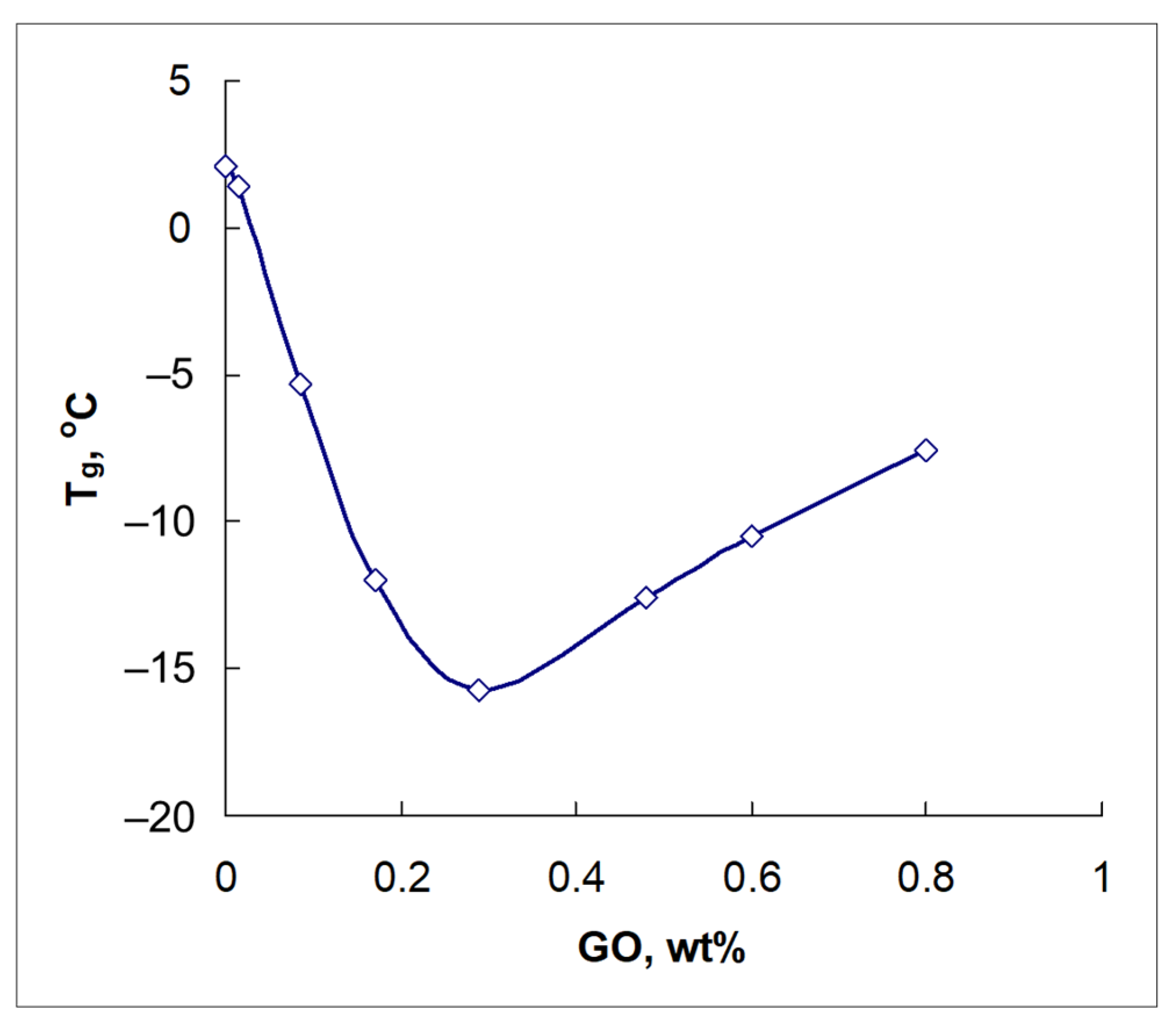
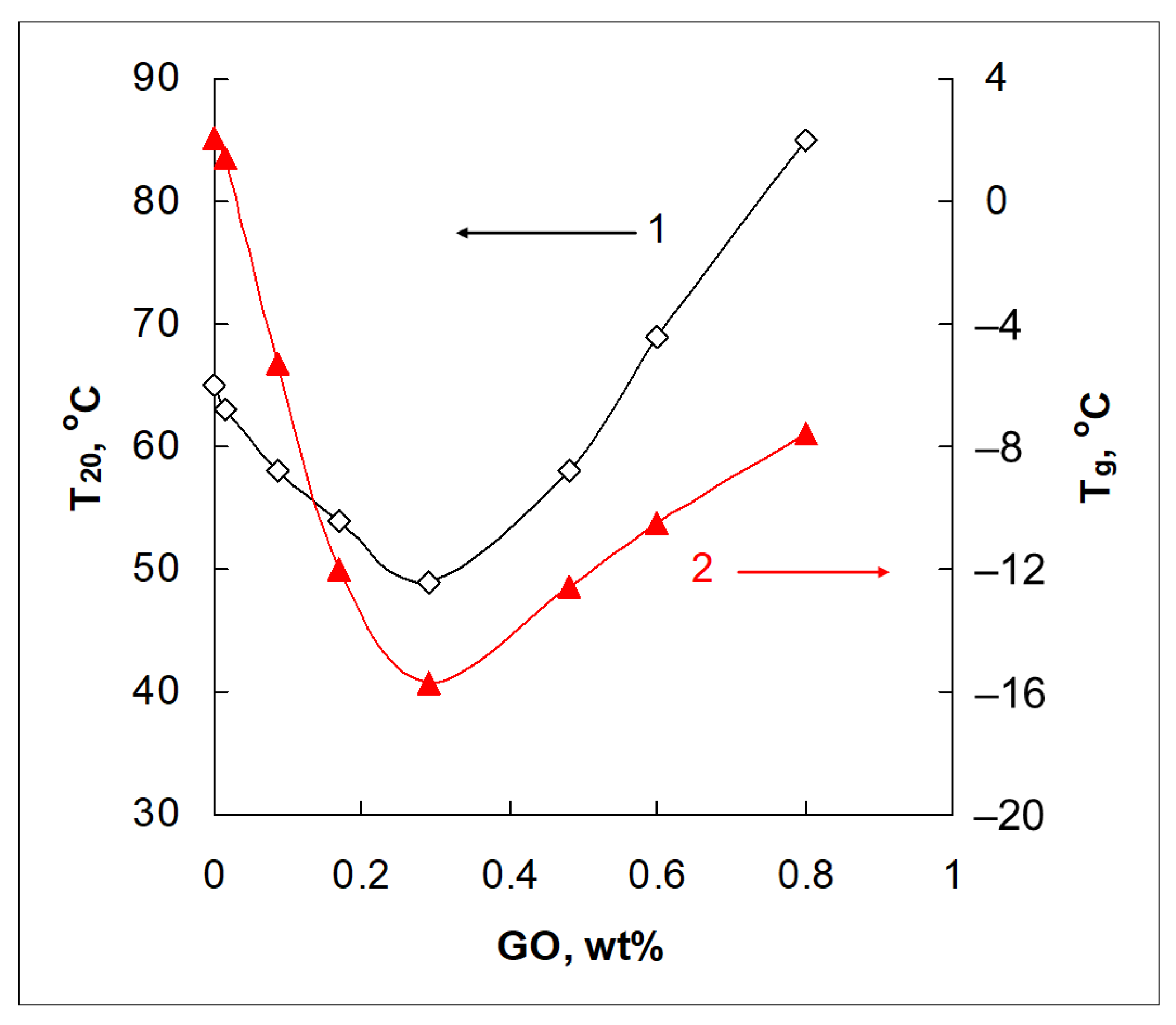
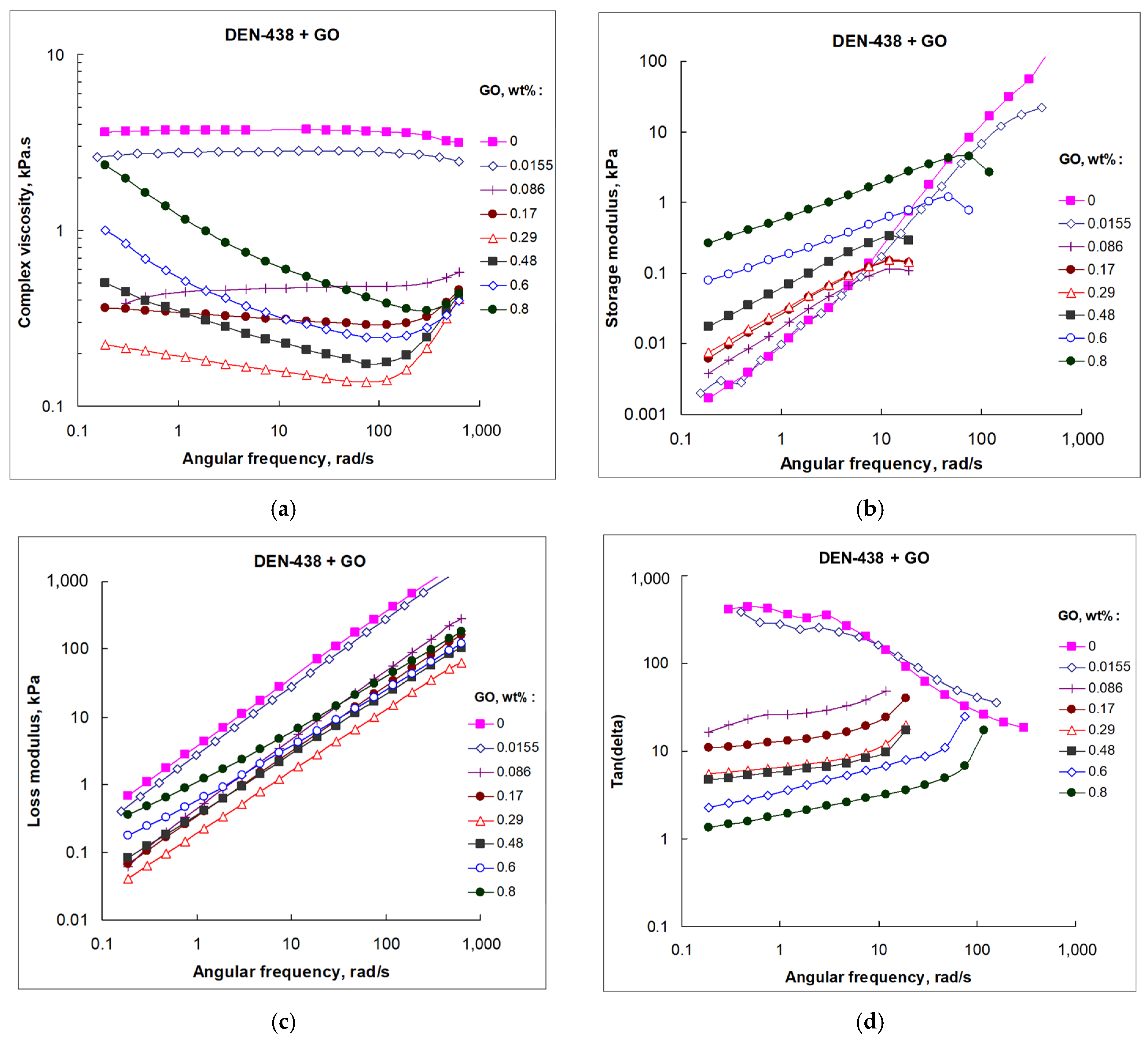
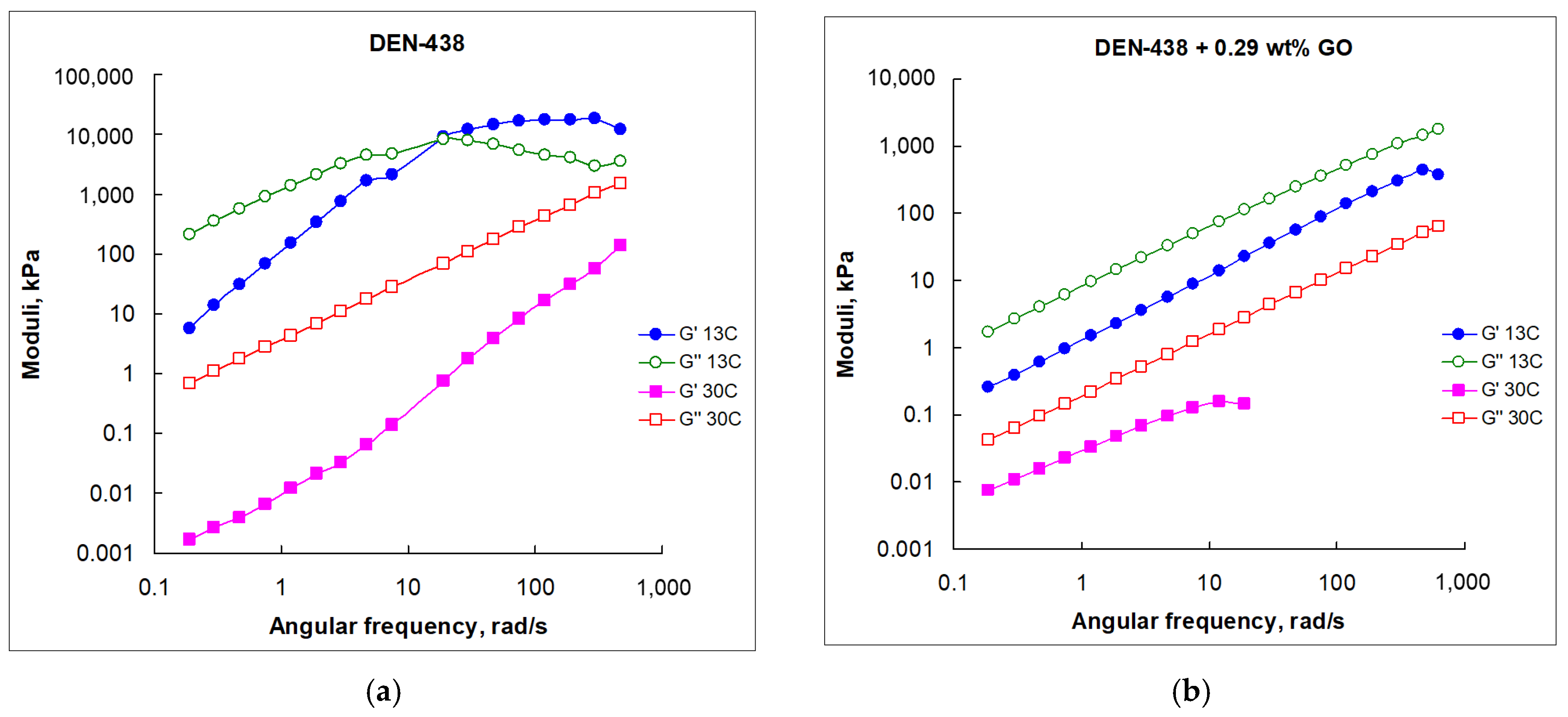
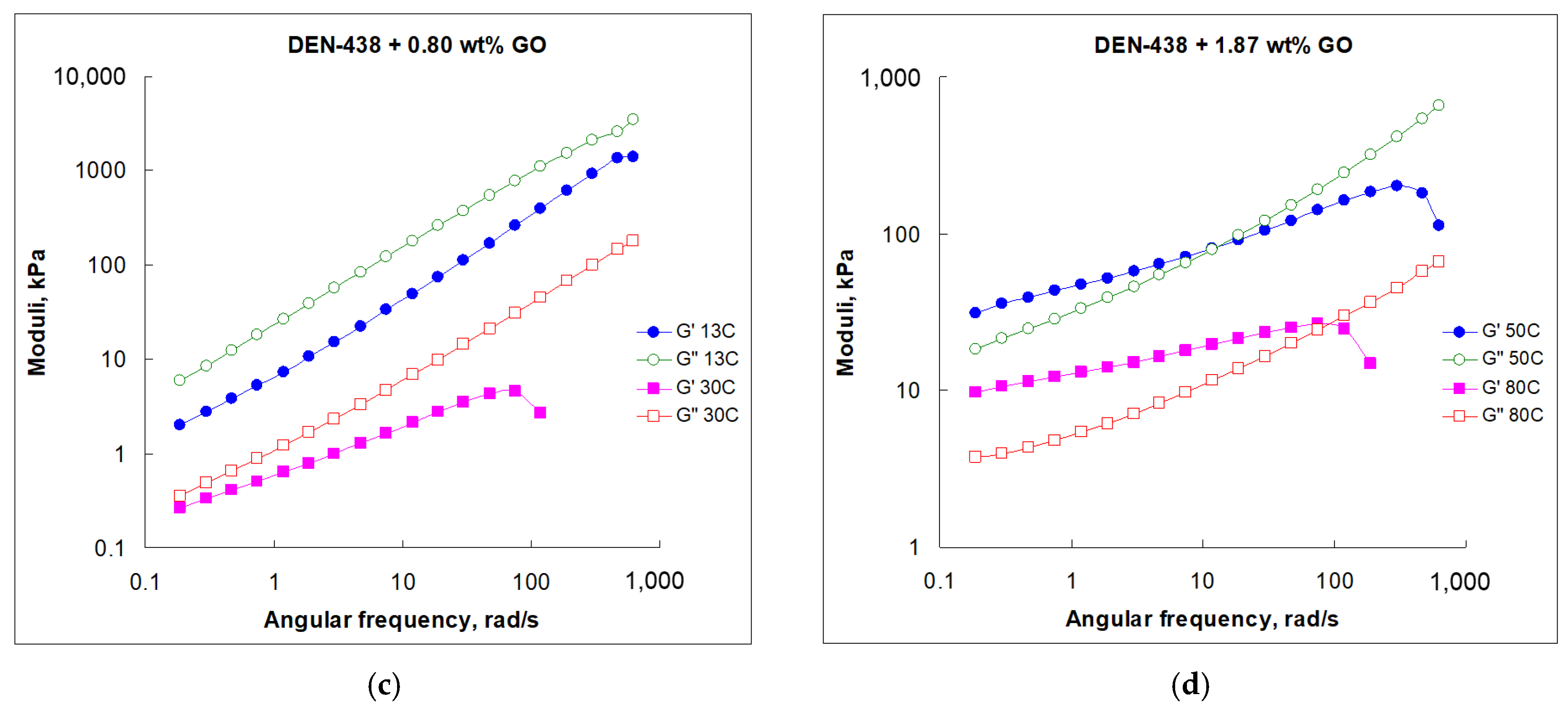
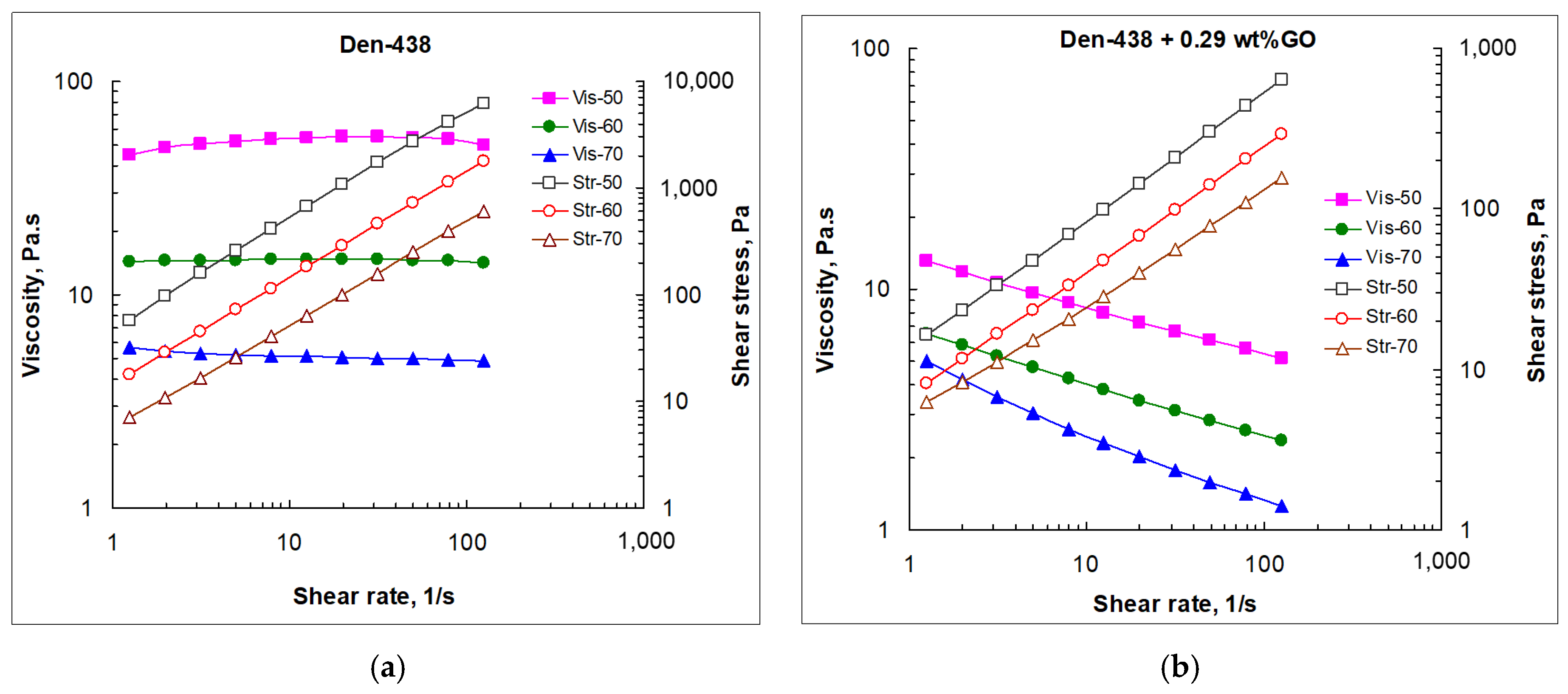
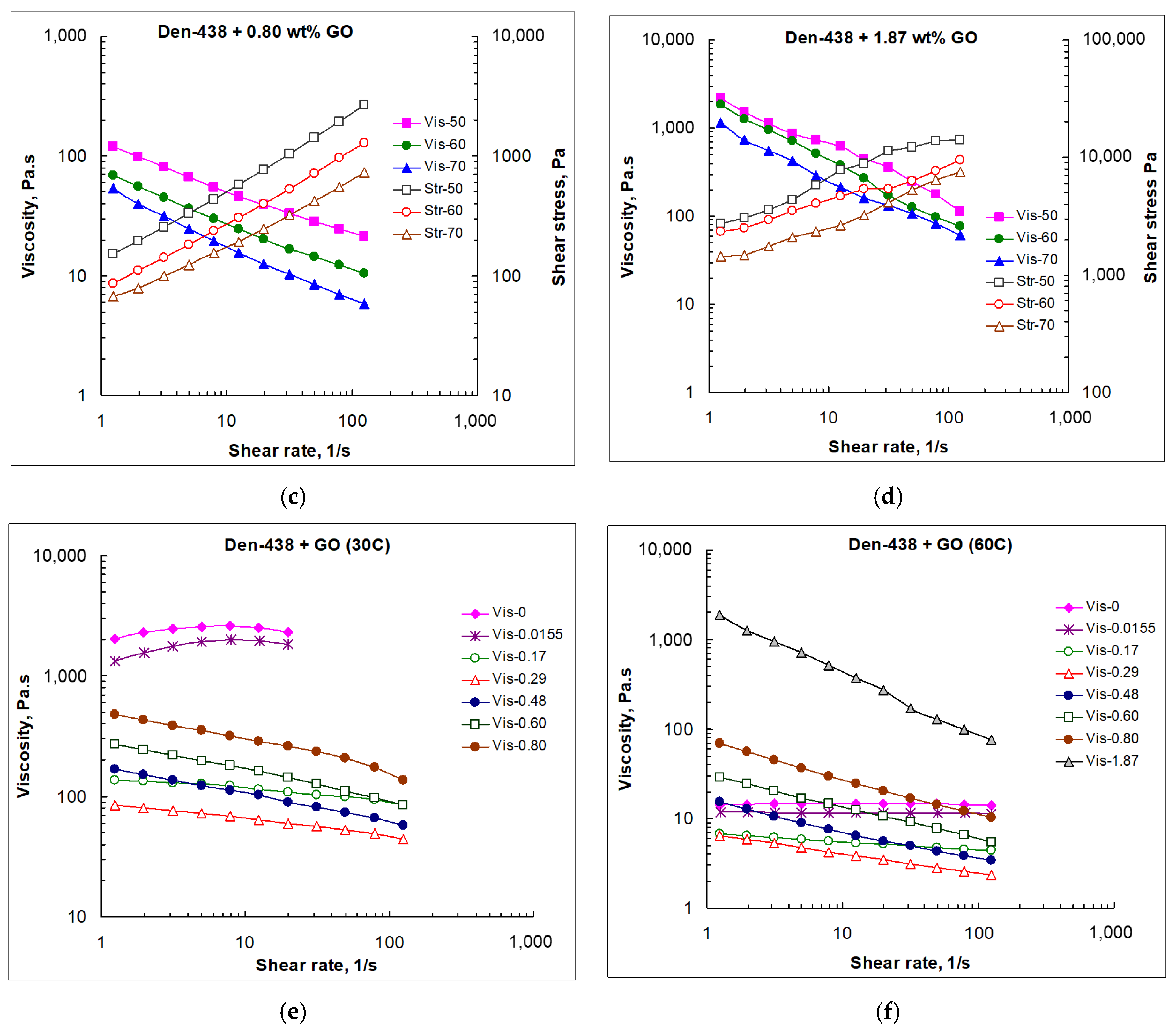
Disclaimer/Publisher’s Note: The statements, opinions and data contained in all publications are solely those of the individual author(s) and contributor(s) and not of MDPI and/or the editor(s). MDPI and/or the editor(s) disclaim responsibility for any injury to people or property resulting from any ideas, methods, instructions or products referred to in the content. |
© 2025 by the authors. Licensee MDPI, Basel, Switzerland. This article is an open access article distributed under the terms and conditions of the Creative Commons Attribution (CC BY) license (https://creativecommons.org/licenses/by/4.0/).
Share and Cite
Amirova, L.M.; Khannanov, A.; Dimiev, A.M.; Amirov, R.R. The Rheology of Graphene Oxide Dispersions in Highly Viscous Epoxy Resin: The Anomalies in Properties as Advantages for Developing Film Binders. Liquids 2025, 5, 32. https://doi.org/10.3390/liquids5040032
Amirova LM, Khannanov A, Dimiev AM, Amirov RR. The Rheology of Graphene Oxide Dispersions in Highly Viscous Epoxy Resin: The Anomalies in Properties as Advantages for Developing Film Binders. Liquids. 2025; 5(4):32. https://doi.org/10.3390/liquids5040032
Chicago/Turabian StyleAmirova, Liliya M., Artur Khannanov, Ayrat M. Dimiev, and Rustem R. Amirov. 2025. "The Rheology of Graphene Oxide Dispersions in Highly Viscous Epoxy Resin: The Anomalies in Properties as Advantages for Developing Film Binders" Liquids 5, no. 4: 32. https://doi.org/10.3390/liquids5040032
APA StyleAmirova, L. M., Khannanov, A., Dimiev, A. M., & Amirov, R. R. (2025). The Rheology of Graphene Oxide Dispersions in Highly Viscous Epoxy Resin: The Anomalies in Properties as Advantages for Developing Film Binders. Liquids, 5(4), 32. https://doi.org/10.3390/liquids5040032







